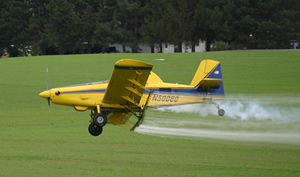
When banning the use of something becomes intractable, it is often best just to narrow the field in which that certain something can be used. This “starving of the beast” strategy is being utilized by the Environmental Protection Agency against a poisonous pesticide that has been used on our crops for decades. Efforts to ban the Carbofuran Pesticide outright have been going on for years now, but the process has been long and un-noteworthy. However the EPA has recently enacted a new set of rules that will largely put a halt to the use of the pesticide better known as Furadan.
This past May 12, the EPA revoked regulations that allow residues of Furadan in food. By making it illegal for different food products to contain trace amounts of Carbofuran, it is effectively banning the use of the product in crop dusting abroad as well as on domestic farms.
While eating one piece of food treated by Carbofuran may not be harmful to your body, the EPA has stated that “aggregate dietary exposure to residues of Carbofuran… is not safe.” As with all chemical exposures, the most prone to danger are children and pregnant women. The chemical affects not only the people who eat the food, but also the farm workers who may breathe in the chemicals, as well as migratory birds.
Included in the list of foods that can no longer be sold with Carbofuran residue are artichoke, banana, coffee bean, corn, cotton, cucumber, grape, melon, milk, oat, potato, raisins, rice, strawberry, squash, sugar cane, wheat and many others. And while this ban is definitely a good move for food safety in the United States, there are still plenty of other harmful chemicals that are sprayed on food in alarming rates. To avoid creating a Petri dish in your blood streams with the ingestion of every chemical company can come up with, try eating organic, untreated foods. The United States Department of Agriculture requires foods with their organic label to be grown without the use of chemical pesticides, fertilizers, hormones, antibiotics and some other substances that, despite scientific data showing harmful consequences, the FDA allows anyway.

